Neamen D. Microelectronics: Circuit Analysis and Design
Подождите немного. Документ загружается.

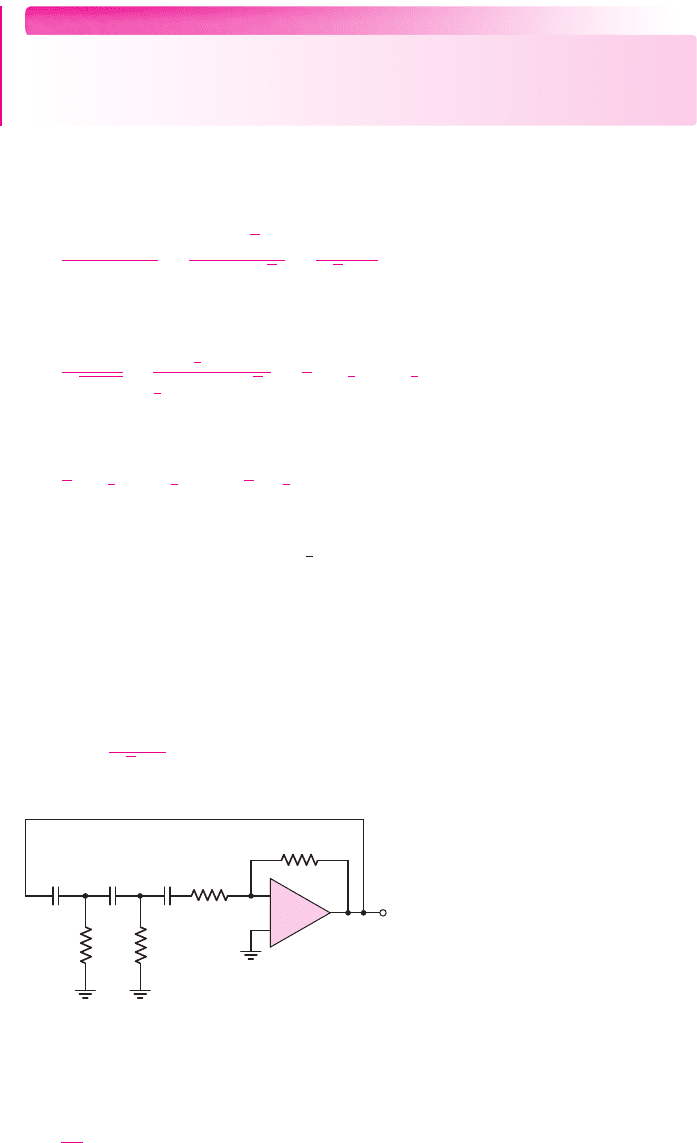
1078 Part 2 Analog Electronics
EXERCISE PROBLEM
Ex 15.4: Design the phase-shift oscillator shown in Figure 15.15 to oscillate at
f
o
= 22.5
kHz. The minimum resistance to be used is 10 k
. (Ans. Set
R = 10
k
,
C = 408
pF,
R
2
= 80
k
)
Using Equation (15.36), we can determine the effect of each RC network in the
phase-shift oscillator. At the oscillation frequency
ω
o
, the transfer function of each
RC network stage is
jω
o
RC
1 + jω
o
RC
=
( j/
√
3)
1 + ( j/
√
3)
=
j
√
3 + j
(15.44)
which can be written in terms of the magnitude and phase, as follows:
1
√
3 + 1
×
90
◦
tan
−1
(1/
√
3)
=
1
2
×[
90
◦
−
tan
−1
(0.577)]
(15.45(a))
or
1
2
×(
90
◦
−
30
◦
) =
1
2
×
60
◦
(15.45(b))
As required, each RC network introduces a 60 degree phase shift, but they each also
introduce an attenuation factor of
(
1
2
)
for which the amplifier must compensate.
The two voltage followers in the circuit in Figure 15.15 need not be included in
a practical phase-shift oscillator. Figure 15.16 shows a phase-shift oscillator without
the voltage-follower buffer stages. The three RC network stages and the inverting
amplifier are still included. The loading effect of each successive RC network
complicates the analysis, but the same principle of operation applies. The analysis
shows that the oscillation frequency is
ω
o
=
1
√
6RC
(15.46)
C
v
O
R
2
R
CC
R
R
–
+
Figure 15.16 Phase-shift oscillator circuit
and the amplifier resistor ratio must be
R
2
R
= 29
(15.47)
in order to sustain oscillation.
nea80644_ch15_1061-1140.qxd 07/12/2009 3:58 Page 1078 pinnacle MHDQ-New:MHDQ134:MHDQ134-15:
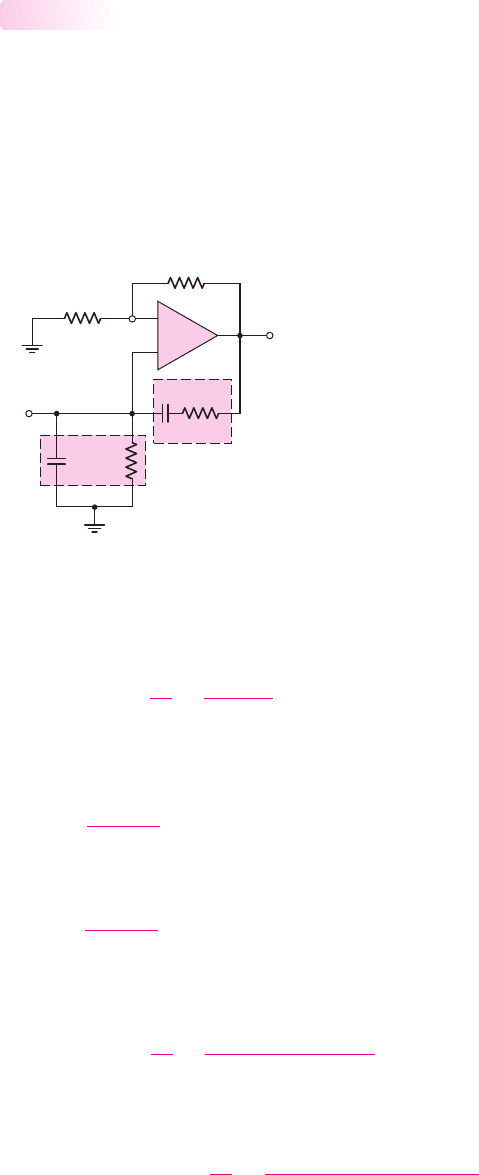
Chapter 15 Applications and Design of Integrated Circuits 1079
Wien-Bridge Oscillator
Another basic oscillator is the Wien-bridge circuit, shown in Figure 15.17. The cir-
cuit consists of an op-amp connected in a noninverting configuration and two RC net-
works connected as the frequency-selecting feedback circuit.
Again, we initially assume that an input signal exists at the noninverting termi-
nals of the op-amp. Since the noninverting amplifier introduces zero phase shift, the
frequency-selective feedback circuit must also introduce zero phase shift to create
the positive feedback condition.
15.2.3
v
O
R
2
R
1
v
y
v
x
Z
s
Z
p
C
CR
R
(v
I
)
–
+
Figure 15.17 Wien-bridge oscillator
The loop gain is the product of the amplifier gain and the feedback transfer func-
tion, or
T (s) =
1 +
R
2
R
1
Z
p
Z
p
+ Z
s
(15.48)
where
Z
p
and
Z
s
are the parallel and series RC network impedances, respectively.
These impedances are
Z
p
=
R
1 + sRC
(15.49(a))
and
Z
s
=
1 + sRC
sC
(15.49(b))
Combining Equations (15.49(a)), (15.49(b)), and (15.48), we get an expression for
the loop gain function,
T (s) =
1 +
R
2
R
1
1
3 + sRC +(1/sRC)
(15.50)
Since this circuit has no explicit negative feedback, as was assumed in the gen-
eral network shown in Figure 15.14, the condition for oscillation is given by
T ( jω
o
) = 1 =
1 +
R
2
R
1
1
3 + jω
o
RC + (1/jω
o
RC)
(15.51)
nea80644_ch15_1061-1140.qxd 07/12/2009 3:58 Page 1079 pinnacle MHDQ-New:MHDQ134:MHDQ134-15:

1080 Part 2 Analog Electronics
Since
T ( jω
o
)
must be real, the imaginary component of Equation (15.51) must be
zero; therefore,
jω
o
RC +
1
jω
o
RC
= 0
(15.52(a))
which gives the frequency of oscillation as
ω
o
=
1
RC
(15.52(b))
The magnitude condition is then
1 =
1 +
R
2
R
1
1
3
(15.53(a))
or
R
2
R
1
= 2
(15.53(b))
Equation (15.53(b)) states that to ensure the startup of oscillation, we must have
(
R
2
/R
1
)>2
.
DESIGN EXAMPLE 15.5
Objective: Design a Wien-bridge circuit to oscillate at a specified frequency.
Specifications: Design the Wien-bridge oscillator shown in Figure 15.17 to oscillate
at
f
o
= 20 kHz
.
Choices: An ideal op-amp is available and standard-valued resistors and capacitors
are to be used.
Solution: The oscillation frequency given by Equation (15.52(b)) yields
RC =
1
2π f
o
=
1
2π(20 ×10
3
)
= 7.96 ×10
−6
A 10 k
resistor and 796 pF capacitor satisfy this requirement. Since the amplifier
resistor ratio must be
R
2
/R
1
= 2
, we could, for example, have
R
2
= 20 k
and
R
1
= 10 k
, which would satisfy the requirement.
Trade-offs: Standard-valued resistors
R
1
= 10 k
and
R
2
= 20 k
. In place of the
ideal 796 pF capacitor, a standard-valued capacitor
C = 800 pF
can be used. The os-
cillation frequency would then be
f
o
= 19.9 kHz
. Element tolerance values should
also be considered.
Comment: As usual in any electronic circuit design, there is no unique solution.
Reasonably sized component values should be chosen whenever possible.
Computer Simulation Verification: A Computer simulation was performed using
the circuit in Figure 15.18(a). Figure 15.18(b) shows the output voltage versus time.
Since the ratio of resistances is
R
2
/R
1
= 22/10 = 2.2
, the overall gain is greater than
unity so the output increases as a function of time. This increase shows the oscillation
nature of the circuit. Another characteristic of the circuit is shown in Figure 15.18(c).
A 1 mV sinusoidal signal was applied to the input of
R
1
and the output voltage mea-
sured as the frequency was swept from 10 kHz to 30 kHz. The resonant nature of the
circuit is observed. The oscillation frequency and the resonant frequency are both at
approximately 18.2 kHz, which is below the design value of 20 kHz.
nea80644_ch15_1061-1140.qxd 07/12/2009 3:58 Page 1080 pinnacle MHDQ-New:MHDQ134:MHDQ134-15:

Chapter 15 Applications and Design of Integrated Circuits 1081
(a)
C
P
R
S
C
S
796 pF
796 pF
R
P
R
1
R
2
U
1A
LM324
v
1
v
2
3
4
1
2
11
0
0
0
22 kΩ
V
10 kΩ
10 kΩ
10 kΩ
5 V
+
–
v–
v+
+
–
+
–
5 V
V
U1A
(out) (mV)
–173.8528
–173.8530
–173.8532
–173.8534
–173.8536
–173.8538
0 100 200 300 400 500
Time (m s)
(b)
V
U1A
(out) (mV)
40
30
20
10
0
10 20 30 40 50
60
70 90
(c)
Frequency (kHz)
Figure 15.18 (a) Circuit used in the computer simulation for Example 15.5, (b) output
voltage versus time, and (c) output voltage versus input frequency
If the capacitor in the circuit is reduced from 796 pF to 720 pF, the resonant fre-
quency is exactly 20 kHz. This example is one case, then, when the design parame-
ters need to be changed slightly in order to meet the design specifications.
nea80644_ch15_1061-1140.qxd 07/12/2009 3:58 Page 1081 pinnacle MHDQ-New:MHDQ134:MHDQ134-15:

1082 Part 2 Analog Electronics
R
L
C
2
C
1
Figure 15.19 The ac equivalent
circuit, MOSFET Colpitts oscillator
EXERCISE PROBLEM
Ex 15.5: Design the Wien-bridge circuit in Figure 15.17 to oscillate at
f
o
=
800 Hz
. Assume
R = R
1
= 10 k
. (Ans.
C
∼
=
0.02 μF
,
R
2
= 20 k
)
Additional Oscillator Configurations
Oscillators that use transistors and LC tuned circuits or crystals in their feedback
networks can be used in the hundreds of kHz to hundreds of MHz frequency range.
Although these oscillators do not typically contain an op-amp, we include a brief
discussion of such circuits for completeness. We will examine the Colpitts, Hartley,
and crystal oscillators.
Colpitts Oscillator
The ac equivalent circuit of the Colpitts oscillator with an FET is shown in Fig-
ure 15.19. A circuit with a BJT can also be designed. A parallel LC resonant circuit
is used to establish the oscillator frequency, and feedback is provided by a voltage
divider between capacitors
C
1
and
C
2
. Resistor R in conjunction with the transistor
provides the necessary gain at resonance. We assume that the transistor frequency
response occurs at a high enough frequency that the oscillation frequency is deter-
mined by the external elements only.
Figure 15.20 shows the small-signal equivalent circuit of the Colpitts oscillator.
The transistor output resistance
r
o
can be included in R. A KCL equation at the out-
put node yields
V
o
1
sC
1
+
V
o
R
+ g
m
V
gs
+
V
o
sL +
1
sC
2
= 0
(15.54)
and a voltage divider produces
V
gs
=
⎛
⎜
⎜
⎝
1
sC
2
1
sC
2
+sL
⎞
⎟
⎟
⎠
· V
o
(15.55)
Substituting Equation (15.55) into Equation (15.54), we find that
V
o
g
m
+sC
2
+(1 +s
2
LC
2
)
1
R
+sC
1
= 0
(15.56)
15.2.4
+
–
V
gs
V
o
g
m
V
gs
C
2
C
1
R
L
Figure 15.20 Small-signal equivalent
circuit, MOSFET Colpitts oscillator
nea80644_ch15_1061-1140.qxd 07/12/2009 3:58 Page 1082 pinnacle MHDQ-New:MHDQ134:MHDQ134-15:
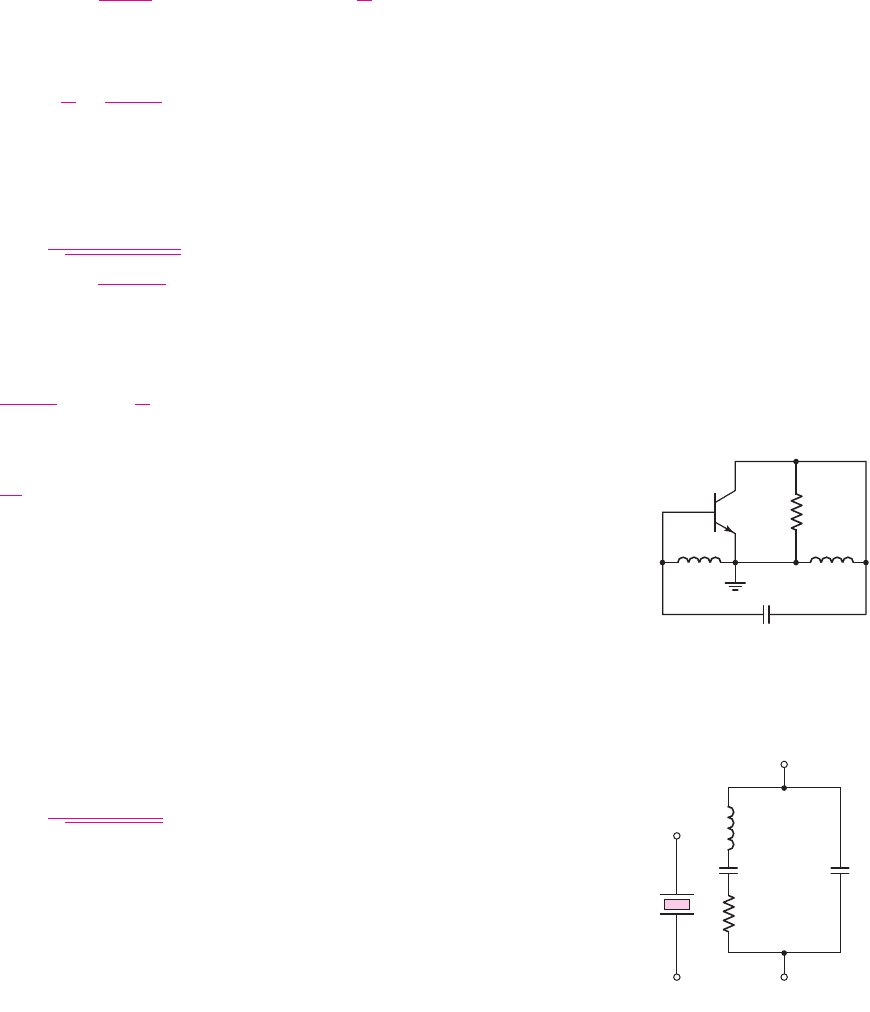
Chapter 15 Applications and Design of Integrated Circuits 1083
If we assume that oscillation has started, then
V
o
= 0
and can be eliminated
from Equation (15.56). We then have
s
3
LC
1
C
2
+
s
2
LC
2
R
+s(C
1
+C
2
) +
g
m
+
1
R
= 0
(15.57)
Letting
s = jω
, we obtain
g
m
+
1
R
−
ω
2
LC
2
R
+ jω[(C
1
+C
2
) − ω
2
LC
1
C
2
] = 0
(15.58)
The condition for oscillation implies that both the real and imaginary compo-
nents of Equation (15.58) must be zero. From the imaginary component, the oscilla-
tion frequency is
ω
o
=
1
L
C
1
C
2
C
1
+C
2
(15.59)
which is the resonant frequency of the LC circuit. From the real part of Equa-
tion (15.58), the condition for oscillation is
ω
2
o
LC
2
R
= g
m
+
1
R
(15.60)
Combining Equations (15.59) and (15.60) yields
C
2
C
1
= g
m
R
(15.61)
where
g
m
R
is the magnitude of the gain. Equation (15.61) states that to initiate
oscillations spontaneously, we must have
g
m
R >(C
2
/C
1
)
.
Hartley Oscillator
Figure 15.21 shows the ac equivalent circuit of the Hartley oscillator with a BJT.
An FET can also be used. Again, a parallel LC resonant circuit establishes the oscil-
lator frequency, and feedback is provided by a voltage divider between inductors
L
1
and
L
2
.
The analysis of the Hartley oscillator is essentially identical to that of the
Colpitts oscillator. The frequency of oscillation, neglecting transistor frequency
effects, is
ω
o
=
1
√
(L
1
+ L
2
)C
(15.62)
Equation (15.62) also assumes that
r
π
1/(ωC
2
)
.
Crystal Oscillator
A piezoelectric crystal, such as quartz, exhibits electromechanical resonance charac-
teristics in response to a voltage applied across the crystal. The oscillations are very
stable over time and temperature, with temperature coefficients on the order of 1 ppm
per
◦
C. The oscillation frequency is determined by the crystal dimensions. This
means that crystal oscillators are fixed-frequency devices.
The circuit symbol for the piezoelectric crystal is shown in Figure 15.22(a), and
the equivalent circuit is shown in Figure 15.22(b). The inductance L can be as high as
a few hundred henrys, the capacitance
C
s
can be on the order of 0.001 pF, and the
R
L
1
C
L
2
Figure 15.21 The ac
equivalent, BJT Hartley
oscillator
L
C
s
C
p
r
(a) (b)
Figure 15.22 (a) Piezo-
electric crystal circuit symbol
and (b) piezoelectric crystal
equivalent circuit
nea80644_ch15_1061-1140.qxd 07/12/2009 3:58 Page 1083 pinnacle MHDQ-New:MHDQ134:MHDQ134-15:
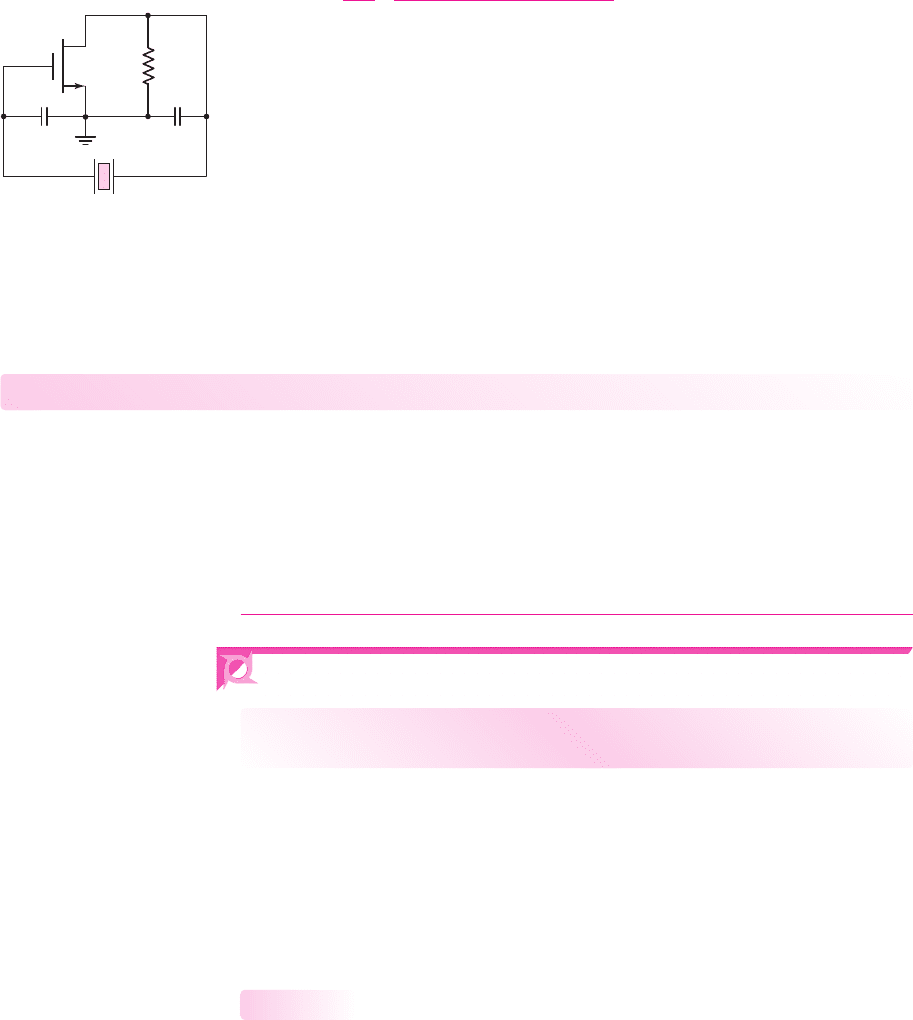
1084 Part 2 Analog Electronics
capacitance
C
p
can be on the order of a few pF. Also, the Q-factor can be on the order
of 10
4
, which means that the series resistance r can be neglected.
The impedance of the equivalent circuit in Figure 15.22(b) is
Z(s) =
1
sC
p
·
s
2
+(1/LC
s
)
s
2
+[(C
p
+C
s
)/(LC
s
C
p
)]
(15.63)
Equation (15.63) indicates that the crystal has two resonant frequencies, which are
very close together. At the series-resonant frequency
f
s
, the reactance of the series
branch is zero; at the parallel-resonant frequency
f
p
, the reactance of the crystal
approaches infinity.
Between the resonant frequencies
f
s
and
f
p
, the crystal reactance is inductive,
so the crystal can be substituted for an inductance, such as that in a Colpitts oscilla-
tor. Figure 15.23 shows the ac equivalent circuit of a Pierce oscillator, which is sim-
ilar to the Colpitts oscillator in Figure 15.19 but with the inductor replaced by the
crystal. Since the crystal reactance is inductive over a very narrow frequency range,
the frequency of oscillation is also confined to this narrow range and is quite constant
relative to changes in bias current or temperature. Crystal oscillator frequencies are
usually in the range of tens of kHz to tens of MHz.
Test Your Understanding
TYU 15.5 Consider the phase-shift oscillator in Figure 15.16. The value of
R
is
15 k
and the frequency of oscillation is
f
o
= 20
kHz. Determine the values of
C
and
R
2
. (Ans.
C = 217
pF,
R
2
= 435
k
)
*TYU 15.6 For the Colpitts oscillator in Figure 15.19, assume parameters of
L = 1 μH
,
C
1
and
C
2
= 1nF
, and
R = 4k
. Determine the oscillator frequency
and the required value of
g
m
. Is this value of
g
m
reasonable for a MOSFET? Why?
(Ans.
f
o
= 7.12 MHz
,
g
m
= 0.25
mA/V)
15.3 SCHMITT TRIGGER CIRCUITS
Objective: • Analyze and design various Schmitt trigger circuits.
In this section, we will analyze another class of circuits that utilize positive feedback.
The basic circuit is commonly called a Schmitt trigger, which can be used in the
class of waveform generators called multivibrators. The three general types of
multivibrators are: bistable, monostable, and astable. In this section, we will examine
the bistable multivibrator, which has a comparator with positive feedback and has
two stable states. We will discuss the comparator first, and will then describe various
applications of the Schmitt trigger.
Comparator
The comparator is essentially an op-amp operated in an open-loop configuration, as
shown in Figure 15.24(a). As the name implies, a comparator compares two voltages
15.3.1
C
2
C
1
R
Figure 15.23 Pierce
oscillator in which the
inductor in a Colpitts
oscillator is replaced by a
crystal
nea80644_ch15_1061-1140.qxd 07/12/2009 3:58 Page 1084 pinnacle MHDQ-New:MHDQ134:MHDQ134-15:

Chapter 15 Applications and Design of Integrated Circuits 1085
+V
S
–V
S
v
O
v
1
v
2
V
L
V
H
v
O
(v
2
– v
1
)
0
–d +d
(a) (b)
–
+
Figure 15.24 (a) Open-loop comparator and (b) voltage transfer characteristics, open-loop
comparator
to determine which is larger. The comparator is usually biased at voltages
+V
S
and
−V
S
, although other biases are possible.
The voltage transfer characteristics, neglecting any offset voltage effects, are
shown in Figure 15.24(b). When
v
2
is slightly greater than
v
1
, the output is driven to
a high saturated state
V
H
; when
v
2
is slightly less than
v
1
, the output is driven to a low
saturated state
V
L
. The saturated output voltages
V
H
and
V
L
may be close to the sup-
ply voltages
+V
S
and
−V
S
, respectively, which means that
V
L
may be negative. The
transition region is the region in which the output voltage is in neither of its satura-
tion states. This region occurs when the input differential voltage is in the range
−δ<(v
2
−v
1
)<+δ
. If, for example, the open-loop gain is 10
5
and the difference
between the two output states is
(V
H
− V
L
) = 10
V, then
2δ = 10/10
5
= 10
−4
V = 0.1mV
The range of input differential voltage in the transition region is normally very small.
One major difference between a comparator and op-amp is that a comparator need
not be frequency compensated. Frequency stability is not a consideration since the com-
parator is being driven into one of two states. Since a comparator does not contain a fre-
quency compensation capacitor, it is not slew-rate-limited by the compensation capaci-
tor as is the op-amp. Typical response times for the comparator output to change states
are in the range of 30 to 200 ns. An expected response time for a 741 op-amp with a slew
rate of 0.7
V/μs
would be on the order of 30
μ
s, which is a factor of 1000 times greater.
Figure 15.25 shows two comparator configurations along with their voltage
transfer characteristics. In both, the input transition region width is assumed to be
negligibly small. The reference voltage may be either positive or negative, and the
output saturation voltages are assumed to be symmetrical about zero. The crossover
voltage is defined as the input voltage at which the output changes states.
Two other comparator configurations, in which the crossover voltage is a func-
tion of resistor ratios, are shown in Figure 15.26. Input bias current compensation is
also included in this figure. From Figure 15.26(a), we use superposition to obtain
v
+
=
R
2
R
1
+ R
2
V
REF
+
R
1
R
1
+ R
2
v
I
(15.64)
The ideal crossover voltage occurs when
v
+
= 0
,or
R
2
V
REF
+ R
1
v
I
= 0
(15.65(a))
nea80644_ch15_1061-1140.qxd 07/12/2009 3:58 Page 1085 pinnacle MHDQ-New:MHDQ134:MHDQ134-15:
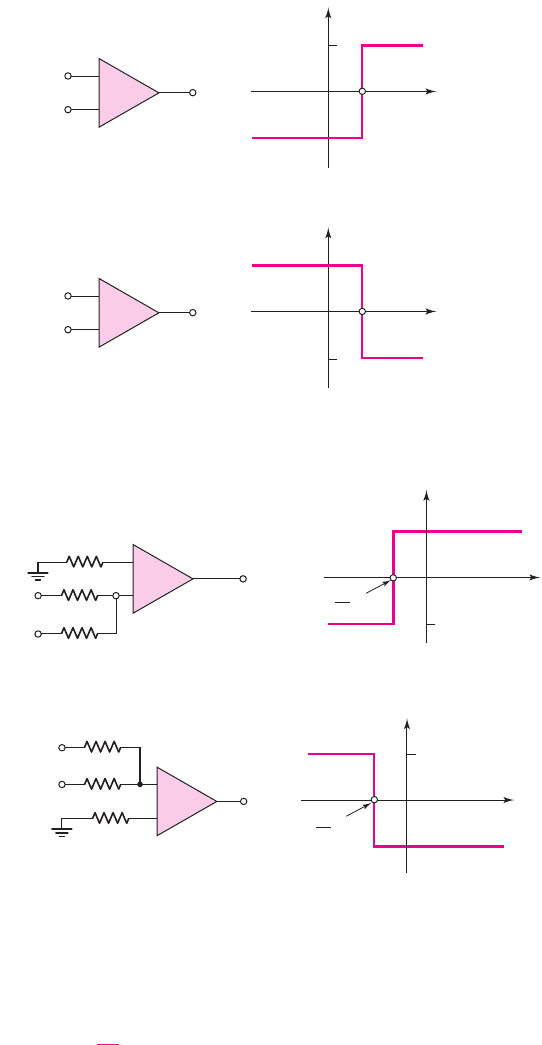
1086 Part 2 Analog Electronics
which can be written as
v
I
=−
R
2
R
1
V
REF
(15.65(b))
The output goes high when
v
+
> 0
. From Equation (15.64), we see that
v
o
=
High when
v
I
is greater than the crossover voltage. A similar analysis produces the
characteristics shown in Figure 15.26(b).
Figure 15.27(a) shows one application of a comparator, to control street lights.
The input signal is the output of a photodetector circuit. Voltage
v
I
is directly
v
O
v
I
V
L
V
H
v
O
v
I
V
L
V
H
V
REF
V
REF
R
1
⎜⎜ R
2
R
1
⎜⎜ R
2
R
1
R
1
R
2
R
2
v
O
v
O
v
I
v
I
v
+
– V
REF
R
2
R
1
– V
REF
R
2
R
1
(a)
(b)
–
+
–
+
Figure 15.26 Other comparator circuits: (a) noninverting and (b) inverting
v
O
v
I
V
H
V
REF
V
L
v
1
= V
REF
v
2
= V
REF
v
2
= v
I
v
1
= v
I
v
O
v
O
v
O
v
I
V
H
V
REF
V
L
(a)
(b)
–
+
–
+
Figure 15.25 (a) Noninverting comparator circuit and (b) inverting comparator circuit
nea80644_ch15_1061-1140.qxd 07/12/2009 3:58 Page 1086 pinnacle MHDQ-New:MHDQ134:MHDQ134-15:
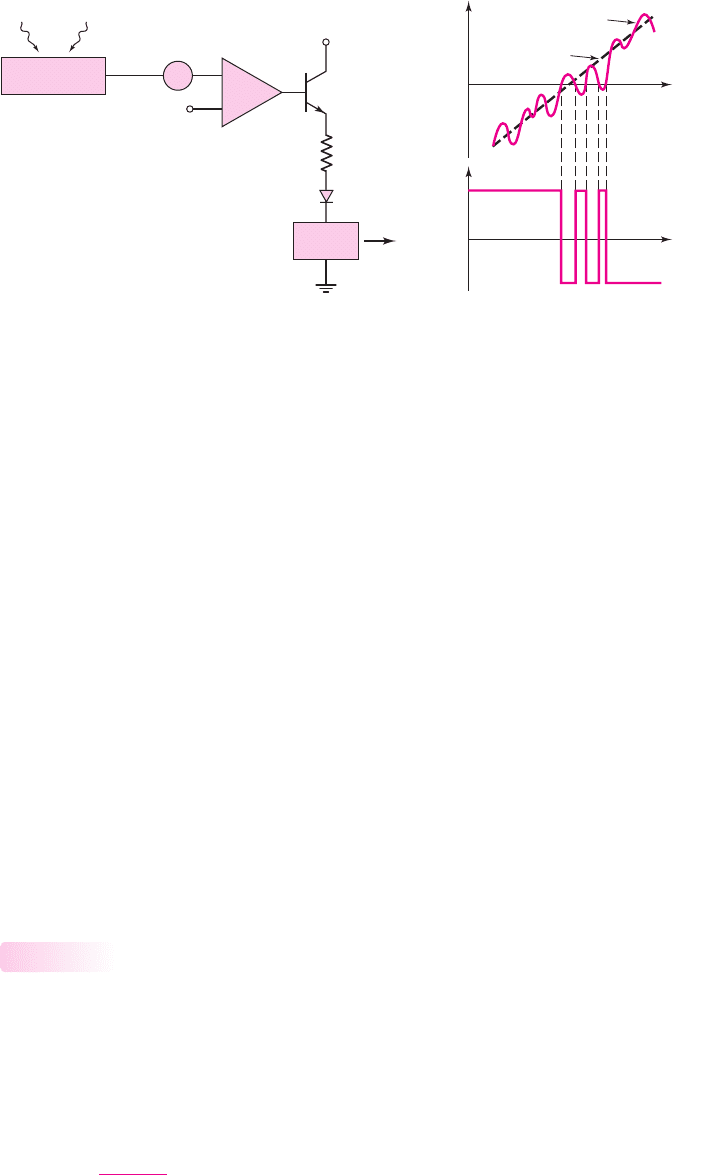
Chapter 15 Applications and Design of Integrated Circuits 1087
proportional to the amount of light incident on the photodetector. During the night,
v
I
< V
REF
, and
v
O
is on the order of
V
S
=+15 V
; the transistor turns on. The cur-
rent in the relay switch then turns the street lights on. During the day, the light inci-
dent on the photodetector produces an output signal such that
v
I
> V
REF
. In this case,
v
O
is on the order of
−V
S
=−15
V, and the transistor turns off.
Diode
D
1
is used as a protection device, preventing reverse-bias break-down in
the B–E junction. With zero output current, the relay switch is open and the street
lights are off. At dusk and dawn,
v
I
= V
REF
.
The open-loop comparator circuit in Figure 15.27(a) may exhibit unacceptable
behavior in response to noise in the system. Figure 15.27(a) shows the comparator
circuit, with a variable light source, such as clouds causing the light intensity to fluc-
tuate over a short period of time. A variable light intensity would be equivalent to a
noise source
v
n
in series with the signal source
v
I
. If we assume that
v
I
is increasing
linearly with time (corresponding to dawn), then the total input signal
v
I
versus time
is shown in Figure 15.27(b). When
v
I
> V
REF
, the output switches low; when
v
I
< V
REF
, the output switches high, producing a chatter effect in the output signal
as shown in Figure 15.27(c). This effect would turn the street lights off and on over a
relatively short time period. If the amplitude of the noise signal increases, the chatter
effect becomes more severe. This chatter can be eliminated by using a Schmitt trigger.
Basic Inverting Schmitt Trigger
The Schmitt trigger or bistable multivibrator uses positive feedback with a loop-
gain greater than unity to produce a bistable characteristic. Figure 15.28(a) shows
one configuration of a Schmitt trigger. Positive feedback occurs because the
feedback resistor is connected between the output terminal and noninverting input
terminal. Voltage
v
+
, in terms of the output voltage, can be found by using a voltage
divider equation to yield
v
+
=
R
1
R
1
+ R
2
v
O
(15.66)
15.3.2
Photodetector
circuit
Relay
switch
Light
Variable
light
v
I
v
n
v
O
v
CC
V
REF
Q
R
D
1
t
t
v
O
V
REF
v
I
′
v
I
(a)
(b)
(c)
–
+
+
–
Figure 15.27 (a) Comparator circuit including input noise source, (b) input signal, and
(c) output signal, showing chatter effect
nea80644_ch15_1061-1140.qxd 07/12/2009 3:58 Page 1087 pinnacle MHDQ-New:MHDQ134:MHDQ134-15:
